New Fractal Antennas for Compact and Versatile Telecommunication Services
Fractus SA
Barcelona, Spain
The wireless telecommunication market is constantly subjected to turbulent and rapid changes. Today’s telecom applications require total mobility as well as constant improvement toward the integration of multiple services. These features, accompanied by an ongoing cost reduction race, have become a challenge for the emerging global communication systems. The introduction of different services necessitates the use of particular antennas for each one since antenna dimensions are linked to their frequency range of operation. This fact contributes to reduced portability and increased final cost of terminals and networks. Fractal technology and other related cutting-edge technologies offer a natural solution for the development of multiband and small antennas. The result is a reduction of the cost and visual impact of the base station. Two antennas with multiband characteristics are presented.
FRACTAL TECHNOLOGY
From classical electromagnetism antenna theory, it is well known that antenna performance is highly dependent on the antenna size-to-wavelength ratio: The antenna must maintain a minimum size with respect to wavelength and its particular size determines the operating band. To operate at different bands, the implementation of different size antennas is usually required. Fractal geometries have been described to present the self-similarity property.1-8 Self-similarity can be loosely described as the geometrical ability of an object to contain copies of itself at several different scales. A related concept is self-affinity, where the object contains replicas that are similar but not equal.6
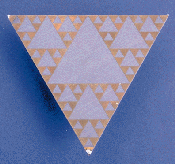 It is also known from antenna theory that a frequency-independent antenna can be obtained when its geometry has certain scalability properties. With this concept in mind, Professor Carles Puente and his team from the Universitat Politècnica de Catalunya (UPC) developed the first multiband fractal-shaped antennas and obtained several invention patents.8-10 As has been demonstrated,2,4 an antenna based on the fractal Sierpinski gasket exhibits a multiband behavior, that is, it has a log periodicity in the input impedance and presents similar radiation patterns at several frequency bands. It is interesting to note that such behavior is due to the self-similarity property of the fractal shape, which is a substantially different property than log-periodicity.6
It is also known from antenna theory that a frequency-independent antenna can be obtained when its geometry has certain scalability properties. With this concept in mind, Professor Carles Puente and his team from the Universitat Politècnica de Catalunya (UPC) developed the first multiband fractal-shaped antennas and obtained several invention patents.8-10 As has been demonstrated,2,4 an antenna based on the fractal Sierpinski gasket exhibits a multiband behavior, that is, it has a log periodicity in the input impedance and presents similar radiation patterns at several frequency bands. It is interesting to note that such behavior is due to the self-similarity property of the fractal shape, which is a substantially different property than log-periodicity.6
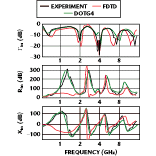 Sierpinski Gasket Properties
Sierpinski Gasket Properties
The Sierpinski gasket monopole, shown in Figure 1 , exhibits a multiband characteristic.2,4 Its multiband operation is intimately linked to its fractal geometry.6 The antenna has an input match to 50 W with a log period of 2, as shown in Figure 2 , and features similar radiation patterns at all bands, as shown in Figure 3 .7 The number of operating bands (five) is directly related to the number of iterations of the antenna (five).
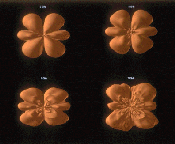 The antenna was carefully analyzed using a finite difference time division (FDTD) algorithm running in a computer at the Centre National de Calcul Paralléle en Sciences de la Terre in Paris. Besides confirming the multiband operation of the antenna (previously described by experimental results), the numerical analysis highlighted the physical behavior of the antenna by revealing the existence of an active region. In a similar sense as in the case of spiral and other frequency-independent antennas, the active region is defined as the portion of the the antenna where the current density is concentrated. Due to the self-similarity property, the current distribution on the antenna at each frequency band is similar but scaled by a factor of 2, explaining the similarity in the radiation patterns and the input impedance at various frequency bands.
The antenna was carefully analyzed using a finite difference time division (FDTD) algorithm running in a computer at the Centre National de Calcul Paralléle en Sciences de la Terre in Paris. Besides confirming the multiband operation of the antenna (previously described by experimental results), the numerical analysis highlighted the physical behavior of the antenna by revealing the existence of an active region. In a similar sense as in the case of spiral and other frequency-independent antennas, the active region is defined as the portion of the the antenna where the current density is concentrated. Due to the self-similarity property, the current distribution on the antenna at each frequency band is similar but scaled by a factor of 2, explaining the similarity in the radiation patterns and the input impedance at various frequency bands.
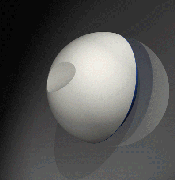 New Dual-band Fractal Antennas
New Dual-band Fractal Antennas
Such results encouraged Fractus SA, in cooperation with the UPC and antenna manufacturer Sistemas Radiantes F. Moyano SA, to explore the possibility of designing base station multiband antennas based on the fractal-shaped antenna concept. Such antennas would operate concurrently at the GSM 900 and GSM 1800 bands. Using these new antennas, telecommunication operators may easily increase the capacity of their existing network while minimizing the environmental and installation costs. The GSM 900 (890 to 960 MHz) and the GSM 1800 (1710 to 1880 MHz) frequency bands are approximately spaced by a factor of 2, therefore, a dual-band antenna for this application should provide multiband operation at frequency ranges spaced by a factor on the order of 2. Two antenna models were developed. The first model is a monopole antenna designed for ceiling mounting; the second is a sectorial-pattern microstrip patch antenna designed for wall mounting.
|
Table 1 | ||
|
|
GSM 900 |
GSM 1800 |
|
Working frequency band (MHz) |
870 to 960 |
1710 to 1880 |
|
Polarization |
vertical | |
|
Horizontal pattern |
omnidirectional | |
|
Gain (dBi) |
3.4 |
6.2 |
|
Maximum power (W) |
50 | |
|
SWR |
<1.5 | |
|
Impedance (W) |
50 | |
|
Intermodulation products |
<-100 | |
|
Front/back relation (dB) |
>18 | |
|
Connector |
1xN (H) | |
|
Electrostatic protection |
grounded | |
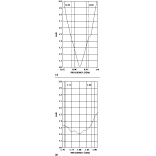 The Fractus-MSPK monopole antenna, shown in Figure 4 , is a derivation of the perturbated Sierpinski gasket monopole.3 The monopole has been constructed with two iterations in order to obtain the two bands of operation. Since the frequency bands are not exactly spaced by a factor of 2 and in order to compensate for the truncation effect, the geometry of the antenna has been distorted to obtain the resonant frequencies at the desired bands. The antenna has a single connector and its input impedance at the resonant frequencies is equal at both bands.
The Fractus-MSPK monopole antenna, shown in Figure 4 , is a derivation of the perturbated Sierpinski gasket monopole.3 The monopole has been constructed with two iterations in order to obtain the two bands of operation. Since the frequency bands are not exactly spaced by a factor of 2 and in order to compensate for the truncation effect, the geometry of the antenna has been distorted to obtain the resonant frequencies at the desired bands. The antenna has a single connector and its input impedance at the resonant frequencies is equal at both bands.
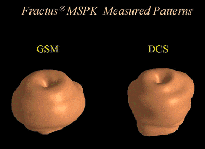 Figure 5 shows the SWR of the antenna, which is lower than 1.4 across both bands. It is also remarkable that the second operating band extends beyond 2000 MHz, which makes the antenna also suitable for operation at the PCS 1900 band. Moreover, the antenna has linear polarization and the radiation patterns are similar at both frequency bands. The typical omnidirectional monopole-like three-dimensional patterns at the GSM 900 and GSM 1800 bands are shown in Figure 6 . The patterns are plotted in a 30 dB dynamic range. The gain of the antenna is greater than 3 and 6 dBi at GSM 900 and GSM 1800, respectively. Table 1 lists the antenna’s performance parameters.
Figure 5 shows the SWR of the antenna, which is lower than 1.4 across both bands. It is also remarkable that the second operating band extends beyond 2000 MHz, which makes the antenna also suitable for operation at the PCS 1900 band. Moreover, the antenna has linear polarization and the radiation patterns are similar at both frequency bands. The typical omnidirectional monopole-like three-dimensional patterns at the GSM 900 and GSM 1800 bands are shown in Figure 6 . The patterns are plotted in a 30 dB dynamic range. The gain of the antenna is greater than 3 and 6 dBi at GSM 900 and GSM 1800, respectively. Table 1 lists the antenna’s performance parameters.
|
Table 2 | ||
|
|
GSM 900 |
GSM 1800 |
|
Working frequency band (MHz) |
870 to 960 |
1710 to 1880 |
|
Polarization |
-45° | |
|
Horizontal pattern |
sectorial 60° | |
|
Gain (dBi) |
7.24 |
7.06 |
|
Maximum power (W) |
50 | |
|
SWR |
<1.5 | |
|
Impedance (W) |
50 | |
|
Intermodulation products |
<-100 | |
|
Front/back relation (dB) |
>15 | |
|
Connector |
2 or 4xN (H) | |
|
Electrostatic protection |
grounded | |
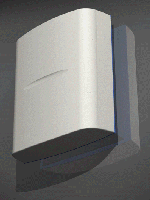 A similar geometry has been employed in the Fractus Panel-02 patch antenna design and construction, shown in Figure 7 . The patch also exhibits a dual-band behavior, as shown in Figures 8 and 9 . The patch is excited by a coaxial feed at two different points. Actually, the antenna can be provided with either a connector for each band or a single connector for both bands. The isolation between input terminals is better than 30 dB at both frequency bands in the two-connector version, which can be useful if an external diplexer is used. Due to its sectorial radiation pattern (60¡ at the horizontal plane), the antenna has been designed to be wall or post mounted in a microcell base station. The gain of the antenna is greater than 7 dBi at both bands. Table 2 lists the antenna’s performance characteristics.
A similar geometry has been employed in the Fractus Panel-02 patch antenna design and construction, shown in Figure 7 . The patch also exhibits a dual-band behavior, as shown in Figures 8 and 9 . The patch is excited by a coaxial feed at two different points. Actually, the antenna can be provided with either a connector for each band or a single connector for both bands. The isolation between input terminals is better than 30 dB at both frequency bands in the two-connector version, which can be useful if an external diplexer is used. Due to its sectorial radiation pattern (60¡ at the horizontal plane), the antenna has been designed to be wall or post mounted in a microcell base station. The gain of the antenna is greater than 7 dBi at both bands. Table 2 lists the antenna’s performance characteristics.
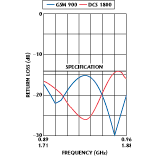 Conclusion
Conclusion
The development of fractal and other related technologies has been successfully translated into real applications. The described antennas for GSM 900 and GSM 1800 cellular system base stations are a clear example of the potential of such technologies to contribute to a major service integration in current and future wireless telecom networks. Additional information may be obtained from the company’s 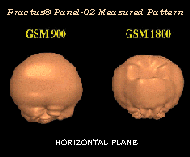 Web site at www.fractus.com.
Web site at www.fractus.com.
Acknowledgment
This work has been partially supported by the European Union and the Spanish government through its grant FEDER TIC2-2FD97-0135 and by Fractus and Sistemas Radiantes F. Moyano. Several aspects of the antennas are patent pending.9,10 The Fractus antennas were awarded the 1998 European Information Society Technology Grand Prize.
References
1. C. Puente and R. Pous, “Fractal Design of Multiband and Low Side-lobe Arrays,” IEEE Transactions on Antennas and Propagation , Vol. 44, No. 5, May 1996, pp. 730-739.
2. C. Puente, J. Romeu, R. Pous, X. Garcia and F. Ben’tez, “Fractal Multiband Antennas Based on the Sierpinski Gasket,” IEE Electronics Letters , Vol. 32, No. 1, January 1996, pp. 1-2.
3. C. Puente, J. Romeu, R. Bartolomé and R. Pous, “Perturbation of the Sierpinski Antenna to Allocate the Operating Bands,” IEE Electronics Letters , Vol. 32, No. 24, November 1996, pp. 2186-2188.
4. C. Puente, J. Romeu, R. Pous and A. Cardama, “On the Behavior of the Sierpinski Multiband Fractal Antenna,” IEEE Transactions on Antennas and Propagation , Vol. 46, No. 4, April 1998, pp. 517-524.
5. C. Puente, J. Romeu, R. Pous and A. Cardama, “Multiband Fractal Antennas and Arrays,” Fractals in Engineering , J.L. Véhel, E. Lutton, C. Tricot (editors), Springer, New York, 1997.
6. C. Puente, Fractal Antennas , PhD dissertation at the department of signal theory and communications, Universitat Politécnica de Catalunya, June 1997.
7. C. Puente, “Fractal Antennas™ -- Fractal Shape Antennas and Arrays,” http://www.tsc.upc.ess/eef/research_antennas.htm, April 1998.
8. C. Puente, R. Pous, J. Romeu and X. Garc’a, “Antenas Fractales o Multifractales,” Invention Patent No. P-9501019.
9. C. Puente, J. Romeu, M. Navarro, C. Borja and J. Anguera, “Antenas Multitriangulares Duales para Telefonía Celular GSM y DCS,” Invention Patent No. 9800954(0).
10. C. Puente, J. Romeu, C. Borja, J. Anguera and J. Soler, “Antenas Multinivel,” Invention Patent No. PCT/ES99/00296.
11. C. Puente, J. Romeu and A. Cardama, “Fractal-shaped Antennas,” Frontiers of Electromagnetics , R. Mittra and D. Werners (editors), IEEE Press.
Fractus SA
Barcelona, Spain
+34 93 206 31 68
